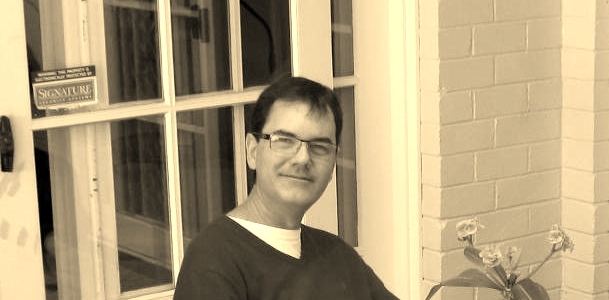Initially posted on youngatheart76@blogspot.com.au
It has been said that one has an influence on everyone they meet in life, positively or negatively, everlasting or fleeting. Everyone I came across in hospital influenced me one way or another, but none more so than Claire O’Brien. Claire was a registered nurse in Ward 8C, where I would, within days, take my first steps since the operation.
When she first walked into the ward to introduce herself to me, the ‘new kid on the block,’ I knew she was ‘different’ to most nurses. The light shone on her long, blonde hair, which sparkled as she moved closer to the window. Her smile was infectious, as I soon became conscious I too was smiling, duplicating her facial expression. Her conversation brought out my best humour, laughter, and aided my recovery in ways medication could not. As she told me to take deep breaths, in and out, I couldn’t help but think she was, herself, a breath of fresh air.
“So you have an interest in politics do you,” she would say as she saw me reading ‘Hawke – A Biography.’ We would go on to discuss cars. “So what car do you drive,” she would ask. “What car does your father drive,” she would continue, having now come to know my dad rather well. “What will you do when you’re discharged from this place,” Claire would continue. “Go to the ‘local’ for a few beers,” was my audacious reply, bringing a grin to my face and laughter to the room. Past girlfriends and other topics of interest would also be mentioned during my stay in recovery.
All the while Claire would be sure to administer the pain relief needed, ensure my heart rate was at an acceptable level. It was invaluable having her there as she was cognizant to my recovery in so many subtle ways.
As I had plenty of spare time to think and ponder, Claire’s ‘way’ of administering patient care made me consciously realise for the first time how important the nurse-patient relationship really was. Did the fact Claire was on duty the vast majority of the time I was in Ward 8C create a relationship between nurse and patient that had the potential to improve the quality of my recovery? The answer, surely, was yes.
There was little time for a nurse-patient relationship to form, but form it did. This would have the effect of personalising the relationship, making me feel at ease in her presence, and reducing any stress or tension I may have had.
It seems I was anything but alone in my discovery of the importance of the nurse-patient relationship. A paper by Mona Shattell in the Journal of Clinical Nursing, 13, 714-722 made available courtesy of Blackwell Publishing, discusses the importance of the nurse-patient relationship and its importance in clinical nursing practice. Shattell discusses social interactionism, of theoretical importance within the field of social psychology.
Social interactionism, put simply, is to say that a person reacts to things based on the meaning those things have for them and the way that person interprets the meaning. The meaning is derived from social interaction, that is, in the case we are discussing here, personal contact between nurse and patient. As Shattell states:
“Research on nurse-patient interactions” has shown that “nurse–patient relationships were able to be formed after very few nurse–patient interactions and of relatively short duration. [Many] patients believed that these relationships were important in their care, and in fact, more important than other aspects of care. Patients wanted nurses to be genuine, not in a hurry, available and willing to talk to them. Patients wanted to be valued and respected as individuals and believed that social interaction was important. Patients did not want to be treated like objects.”
This finding is backed up by Arash Salehi, Lesley Strawderman, Laura Ruff of the Department of Industrial and Systems Engineering Human Systems Engineering Lab, Mississippi State University, in the Journal of the American Academy of Nurse Practitioners, Volume 20, Issue7 in July 2008. Entitled ‘The Importance of Communication for Patient Satisfaction’ they state their study shows “that the number of nurses which patients have talked to was inversely correlated with satisfaction and perceived quality.“
My own recovery proves this point. On discharge from hospital, Claire was there. By 10am that day of Tuesday, 5th October, all that was left was to go to the transit lounge where my meds would be disbursed and I would be on my way.
“Not so fast.” I heard a voice enter the ward. It was Claire. Suddenly I felt myself breathe easier, knowing she was on duty that morning. She had just signed on for her shift. “Don’t be in a hurry,” she advised me. “It’ll take a while for the pharmacy to prepare your medication.” I took my time, as told. But all that stopped me from leaving Ward 8C was the need for a wheelchair, which soon arrived, with the assistance of another nurse, one with whom I was unfamiliar. He would take me from the eighth floor to the third.
As I was slowly wheeled away from the ward that had seen my early recovery from bypass surgery, one I’d always remember, Claire wished me all the best and said: “you might need this.” She handed me a cushion to place over my chest to relieve the pain I’d feel for a while whenever I coughed or sneezed. After all, my breastbone had been opened and would take time to heal.
It was at that moment that I fully comprehended the importance of social interactionism in nursing, the need for ‘face time’ in the nurse-patient relationship and its significant role in improving the quality of recovery and patient care. It was something I’d never forget, something I’d always hold dear to my heart.
Postscript:
Looking about the cardio ward on one of my walks I noticed it was fully occupied by patients of an anglo-celtic background. Or at least it seemed that way to me. Was this co-incidence? Or was there a relationship between heart disease and ethnicity? The best person to answer this question is Sonia Anand, a Canadian epidemiologist. She is attributed with having conducted “the largest study of heart risks worldwide.” Or so the byline to an article entitled ‘Ethnicity, At Its Heart’ by Daniel Grushkin states.
But first, what is ethnicity anyway? Does someone from Poland have the same ethnic background as someone from Pakistan? The answer, clearly, is ‘no.’ According to S. Dindyal, in an article found in The Internet Journal of Third World Medicine. 2004 Volume 1 Number 2 and entitled ‘How Personal Factors, Including Culture And Ethnicity, Affect The Choices And Selection Of Food We Make,’ ethnicity “refers to a social group, which shares certain distinctive features, such as language, culture, physical appearance, religion, values and customs.”
So what was it that Sonia Anand found that was and remains of such interest? As Grushkin explains:-
“In 1997, the epidemiologist and MD at McMaster University found that when South Asians move to Canada, their risk of heart attack mysteriously spikes…Anand theorized that something in their new country is upping their chances for a heart attack.”
And so, with the assistance of “world-renowned cardiologist and epidemiologist Salim Yusuf,” the INTERHEART Study began. It began in 1999 and took five years to complete, included hundreds of researchers around the world and about 30,000 people in communities near and far but the results were worth the effort – and the wait.Grushkin again:
“The study proved that ethnicities worldwide share the same nine risk factors for heart disease. Cholesterol, diabetes, blood pressure, abdominal obesity, smoking, stress, exercise, diet, and alcohol…though some groups were more susceptible to one factor or another (for example, Indians are prone to diabetes and the Chinese more likely to smoke cigarettes), no group showed novel risk factors.”
Anand then found that most risk factors for heart disease are modifiable, that is, behaviour that can be changed has a greater effect on the incidence of heart disease than genetic factors that can’t change. Her finding has been supported by another study out of Ontario, Canada, from 2010. In a CBS News item entitled ‘Heart Risks Vary By Ethnicity: Ontario Study,’ it’s reported that “Chinese, South Asians, whites and blacks…show striking differences in their cardiovascular risk factors.”
It goes on to state that “Smoking and obesity were more common in the white population, while the South Asian and black populations of African or Caribbean descent had the highest levels of diabetes and hypertension, the researchers found.” One of the study authors, Maria Chiu, explains:
“The good news for this story is that these are modifiable risk factors…We can certainly take measures and make lifestyle changes that could prevent a large proportion of cardiovascular diseases.”
This certainly backs up Sonia Anand’s findings and supports that old saying we are all aware of that tells us prevention is better than cure.
So when strolling through the corridors of the cardiothoracic wards on the eighth floor of the hospital at which I was soon to be discharged, I could rest assured the high incidence of Anglo-Celtic patients could be attributed to something other than a higher level of heart disease amongst that ethnic grouping. Co-incidence perhaps? Locality of the hospital? Or was my eyesight playing tricks on me?


Reblogged this on Mona Shattell and commented:
a nice piece — a patient’s perspective on the importance of the nurse-patient relationship. and one of my papers is mentioned. thanks for reading it!
LikeLike
This was such a pleasure to read. Thank you for writing it.
And, I’m glad you found my paper helpful.
Mona
Twitter @MonaShattell
LikeLike
Thanks for the kind thoughts and for re-posting. Hope all’s well in Chicago…
LikeLike